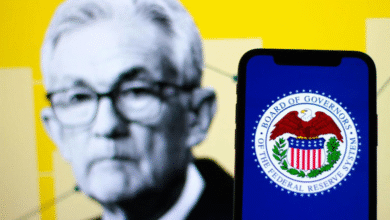Federal Reserve Interest Rates: Goolsbee’s Insights on Tariffs
Federal Reserve interest rates play a pivotal role in shaping the economy, influencing everything from consumer spending to corporate investments. Recently, Chicago Fed President Austan Goolsbee highlighted the challenges presented by fluctuating trade policy and how it complicates potential interest rate changes. His assertions come in light of ongoing discussions regarding tariffs and their impact on inflation, which are key factors for the Federal Reserve to consider. As markets grapple with uncertainty, Goolsbee suggests that maintaining market stability may require the Fed to delay rate adjustments until clearer economic indicators emerge. This cautious approach underscores the interconnectedness of interest rate decisions and trade policy, carving a complex path for economic growth in the near future.
The management of the Federal Reserve’s benchmark lending rates serves as a cornerstone of economic policy, heavily impacting financial environments and the market landscape. Recent statements from key figures, such as Austan Goolsbee of the Chicago Federal Reserve, reflect the intricate relationship between interest rates and shifting trade dynamics, particularly in light of tariff announcements. As global trade policies evolve, their potential repercussions on inflation and consumer behavior become increasingly pertinent to policymakers. The current economic climate, marked by uncertainties around tariffs and their inflationary effects, necessitates a cautious stance from central banks. Therefore, understanding the broader implications of these interest rate adjustments is essential for navigating the complexities of modern economic challenges.
The Impact of Federal Reserve Interest Rates on Economic Stability
The Federal Reserve interest rates serve as a crucial lever for controlling economic stability and inflation. When rates are low, borrowing costs are reduced, stimulating consumer spending and business investments. However, as noted by Chicago Fed President Austan Goolsbee, recent complexities in trade policy, particularly tied to tariffs, have made the Fed’s decision-making process more cautious. This delay in adjusting interest rates can lead to uncertainty in market responses, creating a ripple effect across various economic sectors.
Market stability heavily relies on predictable interest rate changes. If the Fed maintains a prolonged period of stable rates due to uncertainties in trade, this could lead to a stabilization phase in the economic landscape. Businesses might delay investments under inconsistent trade policies, fearing that increased tariffs could diminish their market competitiveness. Therefore, Goolsbee advocates for a careful assessment of trade impacts before the Fed commits to any changes in interest rates.
Frequently Asked Questions
How do Federal Reserve interest rates affect trade policy and tariffs?
Federal Reserve interest rates play a crucial role in shaping the economic environment, which can influence trade policy and tariffs. Higher interest rates often lead to a stronger dollar, making exports more expensive and imports cheaper. Conversely, lower interest rates may weaken the dollar, potentially boosting exports but increasing the cost of imports. The Fed’s decisions on interest rate changes can thus affect firms’ competitiveness in international markets, particularly in light of new tariffs.
What impact do interest rate changes have on inflation according to Austan Goolsbee?
According to Austan Goolsbee, changes in Federal Reserve interest rates can significantly impact inflation. During periods of high tariffs, there is a risk of stagflation, where inflation rises while economic growth stagnates. Goolsbee has indicated that the Fed must carefully assess how trade policies and tariffs contribute to inflation pressures, with a cautious stance on interest rate adjustments until there is more clarity on these issues.
Why has the Fed delayed interest rate changes according to recent statements?
The delay in Federal Reserve interest rate changes, as noted by Austan Goolsbee, is largely due to uncertainty surrounding trade policy. With aggressive tariff proposals and shifting fiscal regulations, the Fed aims to avoid making hasty decisions until they can fully assess the impact of these factors on the economy, inflation, and employment rates.
What did Austan Goolsbee say about market stability in relation to interest rates?
Austan Goolsbee highlighted that the Fed must consider market stability when assessing interest rates. Unpredictable trade policies and tariffs can create volatility in markets, prompting the Fed to maintain a careful approach. The central bank’s goal is to balance economic growth with stable interest rates to minimize disruptions caused by external factors.
How might future Federal Reserve interest rate cuts be influenced by trade policies?
Future Federal Reserve interest rate cuts could be influenced significantly by trade policies and their economic outcomes. If tariffs lead to increased inflation or economic instability, the Fed may have to reconsider its plans on cutting rates. Austan Goolsbee has indicated that while rate cuts are anticipated in the near future, decisions will depend on ongoing assessments of the trade environment and its effects on the broader economy.
| Key Point | Details |
|---|---|
| Fed’s Waiting Period | Fed determined to wait longer on interest rate changes due to uncertainties in trade policy. |
| Goolsbee’s Statement | Austan Goolsbee suggested higher thresholds for action until trade policy clarities are established. |
| Tariff Impact | New tariffs may lead to stagflation, impacting the Fed’s decision on interest rates. |
| Economic Outlook | While uncertain, Goolsbee remains optimistic about long-term economic growth. |
| Next Fed Meeting | The Federal Open Market Committee will meet on June 17-18 to discuss monetary policy. |
Summary
Federal Reserve interest rates are currently in a holding pattern as uncertainty in trade policy continues to loom large. Chicago Fed President Austan Goolsbee indicated that the Fed will wait longer before making adjustments to interest rates, particularly due to the unpredictability created by recent tariff announcements from the Trump administration. As the central bank evaluates the evolving landscape of trade policy and its impact on inflation and employment, the cautious approach taken by Goolsbee suggests that any movement in rates will require significant clarity on trade issues. In the coming months, the Fed remains focused on monitoring economic indicators while preparing to potentially implement rate cuts.




